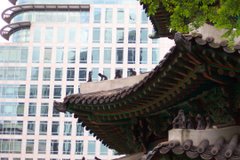The landmark in question is the Chiang Kai-shek Memorial Hall.
+(2)+web+version.jpg)
Created to commemorate Chiang Kai-shek, the long-ruling head of the Chinese Nationalist Party (Kuomintang, KMT) and ruler of Taiwan (after 1949), the Hall was officially opened in 1980, five years after Chiang’s death.
The Hall was apparently modeled after the Temple of Heaven in Beijing.

The not-so-subtle message is the elevation of Chiang to Emperor status and connecting him with a long line of Chinese Emperors stretching back to the mists of antiquity.
Surrounding the Hall is a huge plaza, all enclosed by beautiful tiled walls and gates and filled with trees and flowers. It makes for a very nice location for an early morning jog (or tai chi session).
Inside is an historical museum that highlights all of Chiang’s accomplishments with a health dose of hagiography. Chiang is deliberately and explicitly linked with Sun Yat-sen the founding father of China.
+(Taiwan+2008)+web+version.jpg)
His anti-Japanese exploits are also lauded if also rather exaggerated.
+web+version.jpg)
In keeping with traditional ideals of decorum and solemnity (and enforced by an autocratic regime), disrespectful clothing was banned from the Hall.
+web+version.jpg)
At the top is a massive throne room in which a gargantuan statue of a benevolent Chiang looks down, somewhat Abraham Lincoln-like, upon his subjects.

All of this has been transformed of late. In 1987, martial law was lifted by Chiang’s son and successor Chiang Ching-Kuo . Subsequent elections saw the ousting of the long-ruling KMT in favor of the Democratic Progressive Party (DPP), a group that included many pro-democracy activists. For obvious reasons, DPP leaders were less than fond of Chiang Kai-shek, his often-brutal authoritarianism, and his privileging of so-called mainlanders at the expense of so-called native Taiwanese.
In an effort to use the levers of power to push for the re-imagining of Chiang and his role and legacy in Taiwan, the DPP took on the Memorial Hall, seeking to re-name it the “National Taiwan Democracy Memorial Hall.” Squabbling between KMT and DPP officials (as well as between central government and Taibei City government officials) caused the delay of this change for a number of years. And even after the official change was made, there was a back-and-forth with the sign declaring the new name of the Hall being replaced by the old Chiang Kai-shek sign in the middle of the night etc. But DPP persistence finally triumphed.
Here is the Hall with the new sign affixed:
+(Taiwan+2008)+web+version.jpg)
Not content to rename the Hall, the DPP also redecorated the place. A large and impressive set of murals depicting the struggle against authoritarian rule and for democracy fills the floor of the Hall. Suspended from the ceiling are hundreds of huge kites that add a festive air to the place and not unintentionally obscure a full view of the statue of Chiang. The kites are symbolic of the winds of freedom that have blown through Taiwan of late. I also observe a healthy dose of aboriginal designs and motifs, a not-so-subtle slap at Chiang and the “Mainlanders” who came to Taiwan and usurped power in the late 1940s.
+web+version.jpg)
+web+version.jpg)
+web+version.jpg)
The result is a powerful re-packaging and re-presentation of Taiwan’s history and identity. Now that the KMT has won a huge majority of seats in the Jan 2008 Legislative Yuan election and has a good chance of winning the Presidency in March 2008, one wonders whether the kites are long for this world.

1 comment:
While reading this writing, I found that there are similiarites between ROK and ROC. Particularly, controversies over renaming the Memorial hall and Chiang reminds me of contention as to Former president, Park C.H. between industrialization group and pro-democracrats. As one might anticipate, I think the presidential election will be proceeding in a similar manner.
I am curious of the factors that made it possible to share such common elements between two since the end of Japanese colonization.
Post a Comment